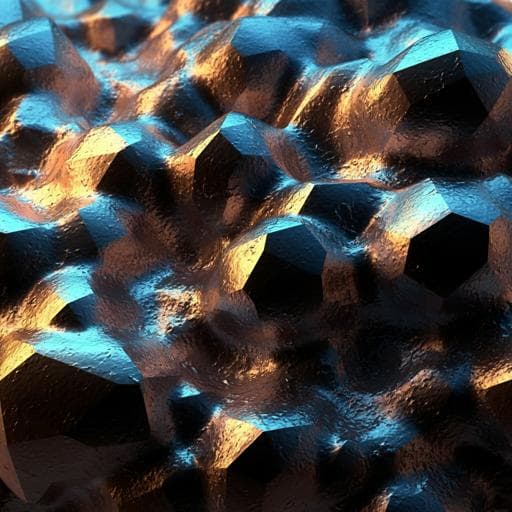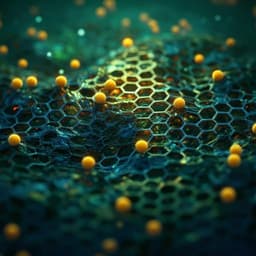
Chemistry
Tailoring the active site for the oxygen evolution reaction on a Pt electrode
K. Iizuka, T. Kumeda, et al.
This groundbreaking study explores highly active electrocatalysts for the oxygen evolution reaction (OER) on single-crystal Pt electrodes, demonstrating how potential cycles can amplify OER activity by creating atomic-sized vacancies. Conducted by Kazuki Iizuka and colleagues, the research uncovers the intricate mechanisms behind enhanced efficiency in water electrolysis.
~3 min • Beginner • English
Introduction
Hydrogen production using renewable energy and its subsequent utilization in fuel cells significantly contribute to a clean energy cycle. Water electrolysis, comprising the hydrogen evolution reaction (HER) and oxygen evolution reaction (OER) at the cathode and anode, respectively, is a useful method for hydrogen production. Polymer electrolyte membrane (PEM) electrolysis enables high-temperature operation and high current densities compared to alkaline solutions. Although high HER activity has been achieved on noble metal electrocatalysts, the large OER overpotential causes significant energy loss, and under acidic conditions enhanced corrosion tolerance is required. Platinum group metals and their oxides (e.g., IrO2 and RuO2) offer appreciable durability as anode materials in acidic media. Pt is widely studied; single-crystal Pt electrodes with well-defined surface atom arrangements enable active-site identification. Numerous surface science techniques (in situ vibrational spectroscopy, X-ray methods, and scanning probe microscopy) have been used to probe interfacial structures.
Pt exhibits multiple oxidation states (PtOH, PtO, PtO2). Adsorbed OH and O at positive potentials can be detected using in situ vibrational and X-ray absorption spectroscopy and ex situ XPS. However, oxidation destroys the well-defined arrangement of surface atoms via place exchange with subsurface atoms. Even for noble metals, at OER potentials the surface becomes highly oxidized, leading to dissolution and/or restructuring of surface atoms.
Complex oxide layers (α-PtO2, β-PtO2) have been suggested at OER-relevant potentials, but few studies have detailed the atomic structure of single-crystal electrodes under these conditions. Recent scanning probe studies observed complex oxide layers at higher potentials, and X-ray diffraction confirmed irreversible oxidation accompanied by place exchange in subsurface layers.
Because electrode reactions are sensitive to surface atomic arrangements, and because single-crystal arrangements cannot be maintained at positive potentials due to subsurface oxidation, it is important to understand structure–activity relations under OER conditions. Prior work holding potentials between 0.8–1.7 V vs RHE on Pt(111) and Pt(100) in acid showed that OER activity decreases with more positive holds (due to highly oxidized species) and, at negative holds, depends on substrate orientation with Pt(100) more active than Pt(111), suggesting substrate atomic arrangement affects Pt oxide structure.
This study examines how OER is influenced by structural changes induced by electrochemical oxidation/reduction cycles on single-crystal Pt electrodes. High-index planes with well-defined step–terrace structures are used to deduce OER active sites, and electron density profiles including the subsurface are determined by X-ray crystal truncation rods (CTRs). The findings show OER activity is sensitive to surface atomic defects produced by potential cycling.
Literature Review
The paper situates its work within extensive literature on Pt oxidation and OER structure sensitivity. Prior studies established: (1) Pt forms multiple oxide/hydroxide species (PtOH, PtO, PtO2) detectable by in situ Raman/IR and X-ray spectroscopies; (2) surface oxidation involves place exchange with subsurface atoms, roughening, and dissolution/restructuring even on noble metals at positive potentials; (3) complex oxide layers (α-/β-PtO2) and stripe oxides on Pt(100) can form under oxidizing conditions; (4) electrochemical roughening produces nanoislands/vacancies observable by EC-STM, with step-edge roughening and place-exchange kinetics characterized; (5) OER activity on low-index Pt surfaces depends on potential protocol; holding at high potentials diminishes activity, and substrate orientation affects activity at negative holds (Pt(100) > Pt(111)). These works motivate probing the detailed, subsurface-resolved structure of active sites on single-crystal Pt during/after redox cycling using surface X-ray diffraction (CTRs) and correlating with voltammetric signatures (e.g., “third hydrogen peak,” vacancy-related features around 0.3 V) on various step–terrace surfaces to determine the vacancy size/terrace width requirements for OER activation.
Methodology
Single-crystal electrodes and electrolytes: Single-crystal Pt beads for voltammetry were prepared by Clavilier’s method. A Pt(111) disk for X-ray measurements was obtained commercially (Mateck). Electrolytes were prepared with ultrapure water: 0.1 M HClO4 and 0.05 M H2SO4 (Kanto Chemical).
Electrode preparation and voltammetry: Samples were annealed with an H2/O2 flame, cooled to room temperature under ultrapure water, and transferred to an electrochemical cell. A reversible hydrogen electrode (RHE) served as reference. Potential cycling to activate OER was initiated by scanning negative from 0.5 V and then cycling between 0.05 and 1.60 V vs RHE at 0.05 V s−1, for up to 50 cycles. Two potential protocols were compared for OER activity at 1.6 V: Protocol I included holding the upper potential limit (EH) between 1.1–1.7 V followed by a negative scan to 0.05 V (oxide reduction) and then scanning to 1.6 V; Protocol II held EH similarly but began the subsequent scan from 1.1 V (without reduction). Electrochemical surface area (ECSA) after designated cycles in 0.1 M HClO4 was determined by transferring the electrode to 0.05 M H2SO4 and integrating charge between 0.05–0.70 V.
Surface structure series: Low-index planes Pt(111), Pt(100), Pt(110) and high-index n(111)-(111) series with defined (111) terrace widths (n = 2, 3, 4, 5, 6, 7, 9, ∞) and stepped surfaces Pt(331), Pt(311), Pt(221), etc., were used to relate terrace width/step structure to OER activation.
X-ray CTR measurements: Surface X-ray diffraction (CTRs) was performed at SPring-8 BL13XU and KEK PF BL3A. Specular CTRs used 20 keV and non-specular CTRs 14 keV X-rays. A drop cell was employed with RHE reference and Au counter immersed in the droplet. Beam size was 100 µm × 100 µm (four-quadrant slit). Detection used a YAP:Ce scintillation detector and a silicon drift detector. CTR intensities were collected along L (surface normal) with Q = Ha* + Kb* + Lc*, where a*b* = 4/√3a, c* = 2π/16a, a = 2.775 Å (nearest-neighbor distance of bulk Pt). Intensities were obtained by rocking scans and corrected for irradiated area, X-ray path length through electrolyte, and Lorentz factor. To avoid additional oxidation/reduction during measurement, CTRs after scans up to 1.6 V were acquired at 1.0 V (before-cycle reference at 0.9 V). 419–440 reflections along specular and non-specular CTRs (131–135 independent after averaging in P3 symmetry) were collected per cycle.
Structural modeling and refinement: Before cycling, the model comprised an adsorbed oxygen layer (H2On or OH) at atop sites above Pt layers. After oxidation to 1.6 V, models included Pt oxide layers (Pt4, O1, O2, O3) and subsurface Pt layers (Pt1, Pt2, Pt3), with Pt allowed on fcc and hcp sites with equal occupancy. Structural optimization used least-squares fitting with ANAROD/ROD programs, refining atomic coordinates, scale, occupancy factors (Occ), and anisotropic Debye–Waller factors within a (1×1) Pt(111) surface unit cell. Goodness of fit (χ2) assessed model agreement.
Data analysis: Specific OER activity (jOER) at 1.6 V was obtained by subtracting background (surface oxidation) current, selecting background at 1.47 V for the 1st cycle and 1.35 V after the 2nd cycle (right before OER onset). ECSA-normalized activities were compared across surfaces and cycles. Vacancy-related voltammetric features around 0.31 V were tracked in both 0.1 M HClO4 and 0.05 M H2SO4 to assess defect formation; step-rich surfaces Pt(331) and Pt(311) were tested to isolate step contributions.
Key Findings
- Potential protocol effect: Including oxide reduction (Protocol I) after holding EH > 1.4 V enhances OER. The anodic current at 1.6 V (j@1.6V) on Pt(111) becomes six times higher than on Pt(100) under Protocol I, in contrast to Protocol II where Pt(100) > Pt(111) and activity decreases with higher EH.
- Cycle-dependent activation: On Pt(111), jOER at 1.6 V increases sharply, peaking on the 3rd cycle at about nine times the initial value, then gradually declines with further cycling. OER onset shifts negatively by ~0.1 V in the 2nd–3rd cycles.
- Surface-specific trends: On Pt(100), jOER is highest in the initial scan and diminishes upon further cycling; Pt(110) shows little change across cycles. After tens of cycles, Pt(111) activity is ~5× higher than Pt(100) and Pt(110), indicating a unique activation mechanism on Pt(111).
- Defect signature: During high-activity cycles, a characteristic redox peak appears at ~0.31 V (hydrogen region) on Pt(111) in both 0.1 M HClO4 and 0.05 M H2SO4, consistent with single-atom vacancies formed by place exchange. The “third hydrogen peak” at ~0.23 V grows after ~10 cycles and is associated with step roughening.
- Step vs vacancy contributions: Stepped surfaces Pt(331) (dense (111) steps) and Pt(311) (dense (100) steps) show j@1.6V comparable to Pt(111) in the 1st cycle but no activation upon cycling, indicating steps alone do not account for activation; sites inside terrace vacancies are implicated.
- Terrace-width requirement: On n(111)-(111) high-index surfaces, activation (increase of j@1.6V by the 3rd cycle) occurs only for terraces wider than five atomic rows (n > 5). Vacancies larger than V3-0 (e.g., V3-1, V7-3) are implicated as OER-active. A second local maximum around ~10 cycles is observed for n ≥ 7, coinciding with development of the third hydrogen peak (step collapse/roughening).
- X-ray CTR structural insights: After initial oxidation to 1.6 V, the topmost Pt atoms are partially lifted (place exchange): Occ(Pt1) ≈ 0.28, Occ(Pt3) ≈ 0.72; d(Pt3–Pt4) expands to 2.46 ± 0.02 Å (from bulk-like spacing). After the 2nd cycle (high activity), d(Pt3–Pt4) further expands to 2.62 ± 0.02 Å; subsurface Occ(Pt2) decreases slightly from 1.00 to 0.96, evidencing defects in the second subsurface layer; oxide layers are disordered with large in-plane DW factors. Overall surface oxide stoichiometry is consistent with PtO2 (ratio of O to Pt ~2 in surface layers). d(Pt2–Pt3) remains bulk-like, indicating the Pt2 layer retains metallic character at the bottom of cavities.
- Mechanistic picture: Potential cycling creates bowl-shaped roughening with atomic-sized vacancies on (111) terraces; defects extending into the second subsurface layer produce high coordination-number Pt atoms at cavity bottoms with weaker O-binding, enhancing water oxidation kinetics. On Pt(100), higher dissolution rates and lack of such stable high-coordination sites lead to declining activity upon cycling.
- Activity normalization: ECSA increases only ~1.2× from the 1st to 50th cycle on Pt(111), while specific activity changes are much larger, indicating intrinsic site activity changes rather than mere surface area increase.
Discussion
The study addresses how structural evolution under oxidative/reductive cycling governs OER activity on Pt single crystals. The key result is that on Pt(111), potential cycling that includes oxide reduction generates terrace vacancies of sufficient size (larger than V3-0) on wide (111) terraces (n > 5), correlating with the emergence of a ~0.31 V redox feature and a substantial enhancement of OER activity (ninefold by the 3rd cycle). Step-rich surfaces do not show analogous activation, isolating vacancies as the critical motif. CTR analysis provides subsurface-sensitive evidence that active surfaces contain defects in the second subsurface Pt layer while maintaining bulk-like spacing between Pt2 and Pt3, implying metallic, high-coordination Pt atoms at the bottoms of bowl-shaped cavities. Such sites likely bind oxygen intermediates more weakly, improving OER kinetics relative to fully oxidized or low-coordination step-edge sites.
These findings reconcile prior observations that highly oxidizing holds suppress OER (due to excessive oxide formation) while controlled cycling with reduction can generate catalytically beneficial defect motifs. The terrace-width dependence explains why crystallographic orientation remains important even under oxidizing conditions: only surfaces capable of hosting larger vacancies (n > 5) develop the active subsurface-defect sites. The contrast with Pt(100) (decreasing activity, higher dissolution) underscores the need for structural stability and the presence of high-coordination metallic sites for sustained OER activity. Overall, the work provides a structure–activity map linking vacancy size/depth and subsurface defects to OER performance, guiding the engineering of Pt surfaces (and possibly other catalysts) to maximize active-site density while mitigating dissolution.
Conclusion
Potential cycling between 0.05 and 1.6 V vs RHE creates OER-active sites on Pt(111), yielding a ninefold activity increase by the third cycle and a ~0.1 V negative shift in OER onset. Activation arises from bowl-shaped roughening that forms atomic vacancies on wide (111) terraces; vacancies larger than V3-0 on terraces with n > 5 are implicated. Surface X-ray CTRs reveal that defects in the second subsurface Pt layer accompany activation, while bottom Pt atoms maintain metallic, high coordination conducive to weaker O binding and enhanced OER. Step structures alone do not activate OER, and Pt(100) surfaces lose activity upon cycling due to instability and dissolution. These insights identify the geometric and subsurface-defect character of active sites, providing a blueprint for tailoring catalyst surfaces for improved OER in acidic media. Future work could quantify the density and size distribution of vacancies under operando conditions, stabilize optimal vacancy motifs without excessive roughening, and extend the design principles to nanostructured catalysts and alloyed systems.
Limitations
- Direct imaging of atomic-scale vacancies on roughened surfaces by EC-STM is difficult; vacancy structures are inferred from island statistics and voltammetric signatures rather than directly resolved.
- In-plane atomic positions within the Pt oxide layers could not be determined due to large in-plane Debye–Waller factors; CTR analysis resolves vertical structure and occupancies but not full lateral ordering.
- CTRs were measured at 1.0 V after scans to 1.6 V to avoid further oxidation/reduction; thus, structures represent post-transient states, not continuously operando at peak OER current.
- Vacancy densities and sizes evolve with cycling; activation declines after additional cycles as vacancies grow and density decreases, complicating steady-state comparisons.
- Findings are based on ideal single-crystal surfaces; translation to real, nanoparticulate or polycrystalline catalysts may require consideration of additional factors (grain boundaries, support interactions, mass transport).
Related Publications
Explore these studies to deepen your understanding of the subject.







